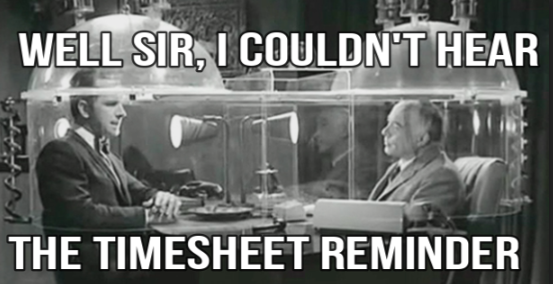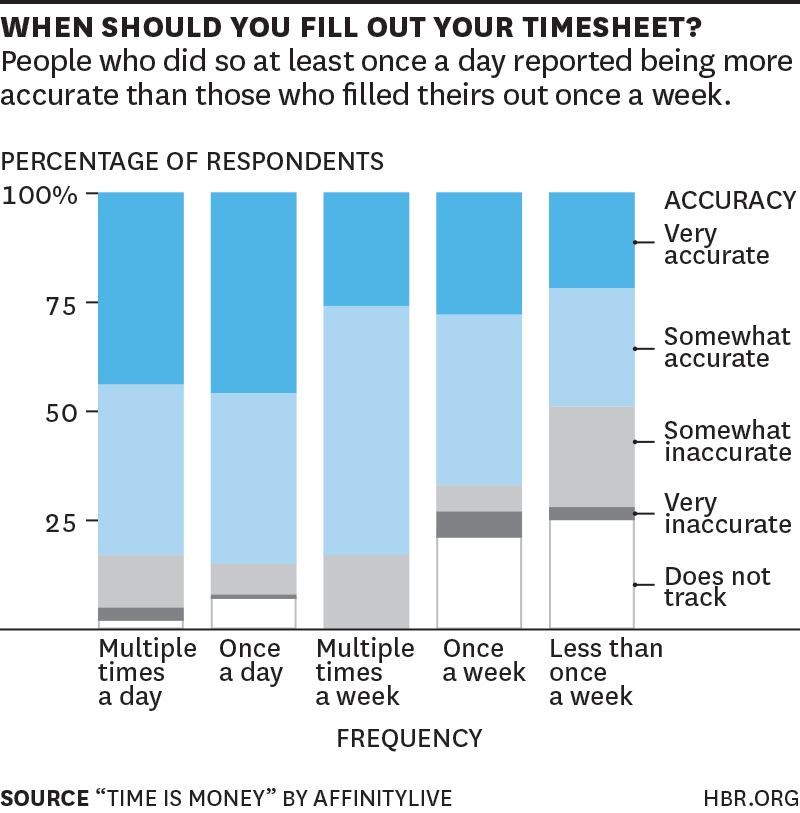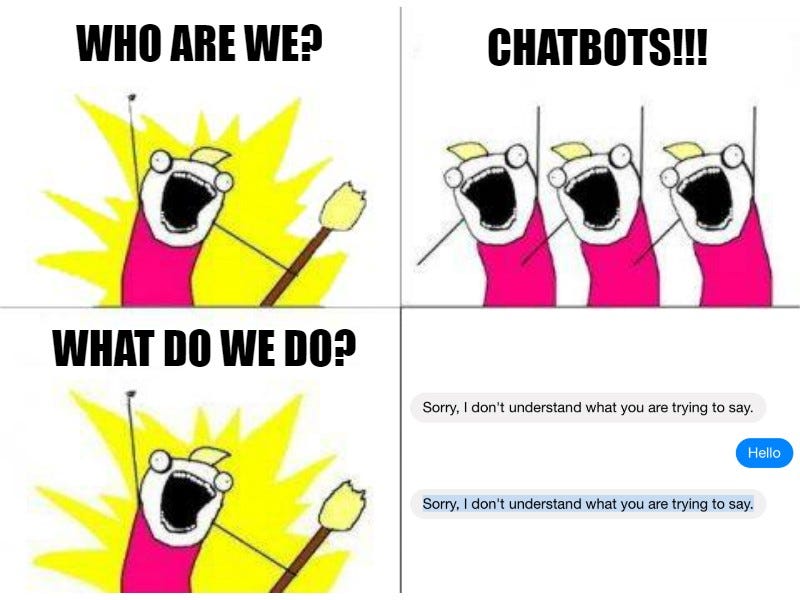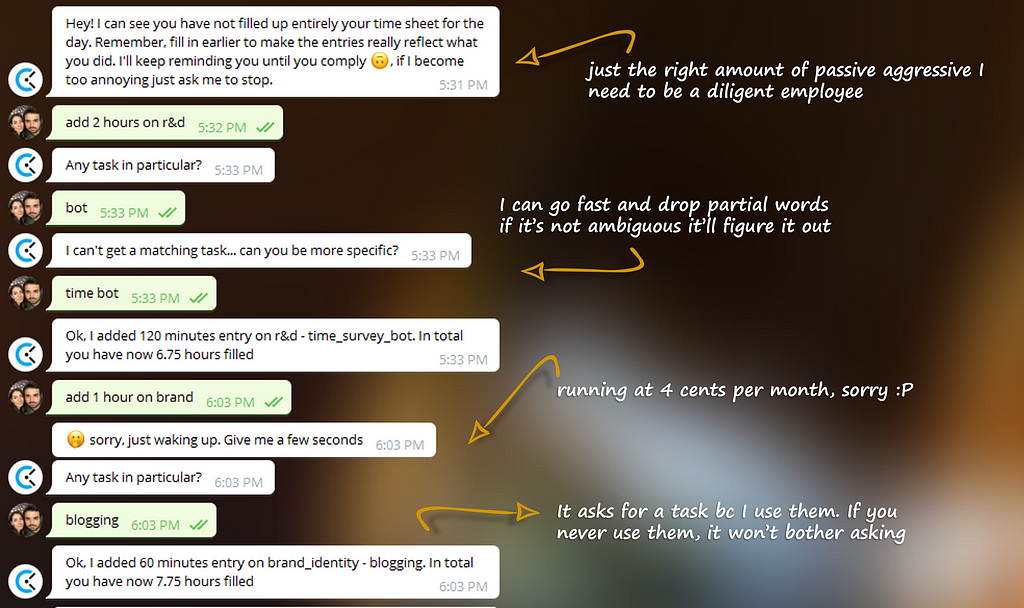Your cart is currently empty!
Time tracking for the busy and lazy: can chatbots help you?

Let’s face it: tracking time sucks. It’s boring, demanding, and something we don’t feel as productive as the work itself.
We treat it like something we can skip or do poorly, right? Well, it’s quite the contrary.
Especially for professional services and agencies, time is money. Literally.
In 2015, a study from AffinityLive estimated that the U.S. economy is losing around $7.4 billion a day due to employees bad time tracking.
Over the last few years, a lot of tools and apps have been released to ease this task and enable more quality tracking: Harvest, Toggl, Clockify, to name a few. They all aim there.
So that’s it, right? Nope.
The majority of us still hate it.

Our own struggle
We were having similar issues in xtream, the startup I co-founded.
Ok, we weren’t losing billions a day 🙂. Yet the poor quality of our timesheets impeded us from trusting the value of some mission critical quantitative metrics.
How can you compare projects profitability when you have only a rough idea of the time spent on them? How can you bill customers accurately, without risking underbilling because you didn’t account for some extra work you did?
It wasn’t a lack of tracking: we were all using Clockify apps, filling timesheets with worked hours on projects and tasks.
It was a lack of accuracy: we were filling our timesheets only when due (like end of month reporting) or once a week top.
So either we spent our entire Friday thinking about what the hell we had done over the past few days, or our timesheet was pretty much a guess.

Point taken: you simply cannot remember all that stuff for much longer than a day.
We know, we know. You can use timers, yay!
No, we don’t want to use timers. You forget to start them, you forget to stop them, you get a bunch of meaningless entries in your sheet… bleah 🤮
I mean, if you’re happy with timers or with manually inserting entries in your sheet once every few weeks in a frustrating guessing game, good for you.
If you hope of a better way, read on.
Trending Bot Articles:
2. Automated vs Live Chats: What will the Future of Customer Service Look Like?
4. Chatbot Vs. Intelligent Virtual Assistant — What’s the difference & Why Care?
Enter the power of chatbots
What was really blocking us?
Reacting is easier than acting: we had nothing to assist us and to remind us of our daily duty. When we tried setting up just a simple notification broadcasted to everyone, our accuracy improved substantially.
Boring tasks cannot steal from your best time: it was not only a matter of effort (let’s be honest, it really isn’t that hard to press a couple of buttons), but of platform. Productivity apps are better used on your laptop, or at least with a working mindset. Even when you use them on your phone… it just feels like work — you know what I mean?
That’s when we started experimenting with a chatbot. Something easy and fun to play with, proactively reminding you to be diligent in your timesheet, and most importantly available on a platform where we all are at any time, where we feel relaxed and comfy. Which for us was Telegram.
This was 2020. Truth be told, pandemic had left us with quite a few extra hours with nothing to do. Which is not ideal for an agency, but for R&D projects is gold material: we were able to dig in deeper than we would have normally. What came out of the cylinder was a chatbot powered by AI technologies for NLP, like Microsoft LUIS, developed with Microsoft Bot Framework and released on our Azure cloud.

It’s quite mouthful, but it truly isn’t much. In a couple of weeks we had a running chatbot and we started using it.
We kept a KISS approach: keep it simple, stupid! We didn’t develop any of the time tracking stuff and none of the features of any of those products. We just took our Clockify workspace and we integrated it, via API, with our chatbot.
One year later, we look back and we feel like we solved time tracking.
No, not for everyone and not every time: late and inaccurate timesheets still occur, and we try our best to avoid them. But 76% of our time entries are filled via chatbot, which means that are recorded the same day they are worked. Remember the chart above? This translates into substantial improvement in accuracy.
That’s why we chose to make it publicly available. If it helped us, it could help someone else. Everyone with a Clockify account can start using our chatbot for free right away.
As of now we support Telegram and Teams. Just click on the links and you should be able to start chatting in a matter of seconds.
Slack may follow easily, if we see there’s a need to. If you’d like it to be on other platforms as well, just let us know in the comment section down below 🙃.
Similarly, we don’t need to stop at Clockify. If you think you’d need this as we do, but your favourite tool is different, let us know. It might be easy to integrate.
How does it look like?

I won’t bore you with the technicalities of how it’s done.
Just know that if you want to have a look at its internals, you can check out the source code yourself, there’s no black magic: we wanted it to be completely transparent in the way it is written.
I do want to show you how it looks though.
Here I am, at 5.30 in the afternoon, finishing up this article. What happens?

The bot reminds me that I’m approaching end of day, and therefore I realistically know what I did today. If I ignore it, which I do a lot, it reminds me once every hour until I’ve done my duty or shut it (pure evil).
I can fill my timesheet in natural language: it may not seem like much, but it means I can go quick and drop partial words and misspellings, without any hard feeling. Note: I can only fill my hours for the current day, so that it encourages entry accuracy by design.
It asks for a task, but because it knows I use them: for projects where I never use tasks, where I’m ok with project-level, it doesn’t bother asking.
And that’s it guys. That’s how we solved our problem with time tracking.
Since then we found ourselves diligently filling our timesheets much more frequently and in a variety of situations that don’t relate to work: on the subway, while watching our night Netflix, or when we take a ☕️ before bed.
Hope it can help you too!
Wrapping up
You can start using our bot as you like, it’s free of charge 👌
If you’re curious or skeptical about its inner parts, don’t hesitate having a look at its codebase: it’s open source and you can drop us an issue for any bug or feature you may want. Write us at oss@xtreamers.io if you don’t know what GitHub is but you still have questions for us.
If you want to know more about who is behind this bot madness, check out our company website. We are a small startup, and we love this stuff.
If you have better ideas on how to solve the time tracking problem, or you think our solution sucks, let us know in the comments.
Don’t be too harsh though.
We’re engineers, but we have feelings too.
Happy tracking! 👋
Don’t forget to give us your 👏 !




Time tracking for the busy and lazy: can chatbots help you? was originally published in Chatbots Life on Medium, where people are continuing the conversation by highlighting and responding to this story.